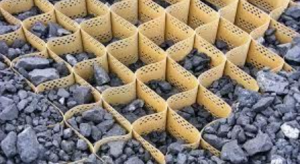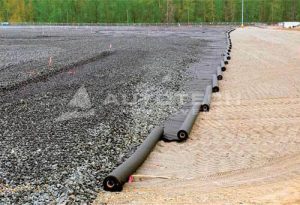Non-Woven Geotextile Drainage Fabric | Sizes, Specs, Prices
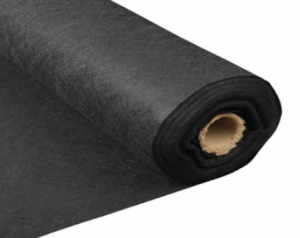
In the matter of the manufacturing of a nonwoven geotextile, there are many various methods used today. The most general manufacturing method is needle-punching. Needle-punched nonwoven geotextile are built by taking a huge number of small fiber fibers and using a barbed needle to interlink the fibers together.
Non-woven geotextile is a category of stabilization fabric made from synthetic polypropylene most oftentimes used for drainage, filtration, erosion control, and sediment reinforcement. Nonwoven geotextile drainage fabric can be efficiently used for filtering applications. On the account of the non-woven geotextile filter fabric’s design, its flow-through rate is steep, letting water pass through while retaining debris and pollutants. Non-woven geotextile is a strong erosion control fabric manufactured of synthetic materials for a variety of applications.
Non-Woven Geotextile Fabric Weight Categories:
Lightweight (2 oz. to 3 oz)
Steep flow rates, under layer cushioning, and drain-field category applications. The 3 oz weight is much-used backing retaining walls to act as a barrier between the dirt and gravel.
Medium weight (4 oz. to 6 oz)
A medium-weight non-woven fabric lets water infiltrate without displacing existing soils. It also supports in controlling soil erosion, separation, and drainage functions (French-drains). Furthermore, we see these weighted fabrics utilized below gravel paths acting as a separation barrier between the gravel and the dirt underneath.
Heavyweight (8 oz. to 16 oz)
Heavyweight non-woven fabrics are extreme for applications requiring strength and absorptive. They are more defiant to puncturing and their durability makes them a good choice behind large rip-rap, Geomembrane cushioning when utilized to retention barriers and artificial lakes. Kindly note that toward the upper edge of the weight spectrum (10 oz +) the water flow rate reduces significantly because of the thickness of the material.
Heavy non-woven is also applied as a separation layer for sand under volleyball courts (8 oz), and to protect the mixing of ballast and soil beneath railroad tracks (16 oz).
Non Woven Geotextile Specification Charts
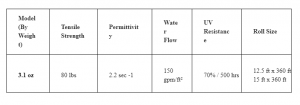
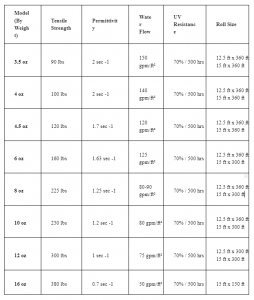
Non-Woven Geotextile characteristics
- Polypropylene Fibers
- Needle-Punched construct
- Rot-Resistant Fabric
Non-Woven Geotextile advantages
- Stable Construction and Design
- Filtration and Drainage Applications
- Manifold Strengths
How much does geotextile fabric price?
The cost of geotextile has a broad range. Rs.15000 rolls are standard for low-grade textiles. Woven geotextile fabric with a high strength class can cost upwards of Rs.2L, based on the size of the roll.
Does water undergo geotextile fabric?
Needle-punched and poly-spun varieties of non-woven geotextile fabric let water easily flow through and are both durable and versatile for landscaping drainage. The non-woven geotextile fabric is most generally used as a landscape material to back adequate drainage, filtration, and ground stabilization.
Nonwoven Geotextile Filter Fabric and further Applications
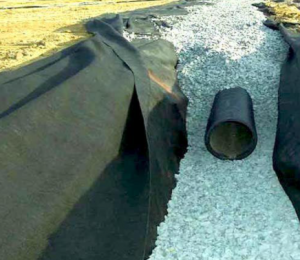
Non-woven geotextile filter fabric can have a variety of applications and uses subjecting to its weight.
Lighter weight geotextile, such as 4 oz non-woven geotextile fabric have been utilized in drainage and landscaping. Further, lighter weight nonwoven geotextile fabric can be applied for asphalt coats to inhibit cracking in asphalt. Non-woven geotextile can be applied as a layer of support. For medium-weight geotextile, such as 6 oz non-woven geotextile fabric and 8 oz non-woven geotextile fabric, applications can contain stabilization, erosion control, and sewerage projects.
Drainage (sewerage) is a common application for non-woven geotextile for drainage. Non-woven geotextile filter fabric is usually used around French drains and underground drains to filter out silt and permit water to pass through. For heavyweight nonwoven geotextile fabric, such as 10 oz non-woven geotextile fabric, applications that need much strength such as road stabilization and Geomembrane cushioning.
Here at oceangeosynthetics.com, we cater to both woven geotextile and nonwoven geotextile – our experts can suggest the best solutions for your applications.

